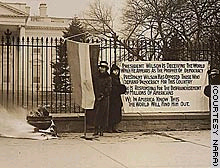
By Thom Patterson
CNN
Friday, August 20, 2004 Posted: 4:59 PM EDT (2059 GMT)

Suffragettes target President Woodrow Wilson during a protest and
bonfire outside the White House.
|
(CNN) -- On August 26, 1920, the United States took a giant democratic leap when Secretary of State Bainbridge Colby certified the ratification of the 19th Amendment to the U.S. Constitution, giving millions of American women the right to vote for the first time in the nation's history.
The landmark event ended a long and, especially in its later years, intense struggle in which women challenged the era's social norms to participate in the political process.
This tension sometimes led to run-ins with the law, as it did three years earlier when female activists -- known as suffragettes -- picketed outside the White House, demanding that President Woodrow Wilson take action. Police arrested 10 protesters on August 28, 1917, just as authorities jailed hundreds of other suffragettes nationwide beginning in June of that year.
By the early 20th century, the women's suffrage movement had generated widespread attention, and with it controversy. Newspapers frequently ran stories of suffragette protests and arrests as well as hunger strikes and prison abuse. Other women's rights activists used humor, parades, vigils and logic -- most any means possible to make their case in the media, courts and government halls.
"Their clashes [with police] and their cooperation [with one another] and the use of nonviolent civil disobedience like chaining themselves to the White House fence and embarrassing the president" did much to win women the right to vote, according to National Organization for Women President Kim Gandy.
"The fact that many of them were arrested and jailed and force-fed ... you can't really imagine, in today's terms, any prisoner being treated that way."
Men dominated America's culture and power structure. Most women were not encouraged to attend college or to build a professional career, but rather they were urged to marry young, bear children and maintain the family home.
The very idea of allowing women the right to vote -- a drastic reform, with females making up roughly half the U.S. population -- was unthinkable to many American men, as well as many women.
Such strict social parameters contributed to the struggles of the American women's movement, which many trace to the 1848 Seneca Falls women's rights convention in upstate New York.
Suffragists employed demonstrations, editorials and legal challenges to win the right to vote, finding gradual but extremely sluggish success. The first amendment proposal came before Congress in 1878, more than 40 years before the 19th Amendment eventually was ratified.
Amid a slowly more liberal social climate, suffragettes stepped up their efforts. Using subtle as well as direct means, the activists adapted their strategy, including targeting one state at a time. By 1912, for instance, nine Western states had granted women voting rights in state and local elections.
The various arrests, alleged prison abuses and other high-profile public ploys all brought further attention to the cause, helping make it a national issue.

Activists began White House pickets from this building, a
headquarters of the suffrage movement.
|
According to "A History of the American Suffragist Movement" by Doris Weatherford, "newspapers were full of stories of the pain that these women endured when jailers jammed tubes down their throats [to break hunger strikes], gagging and nauseating them.
"Their obvious devotion to the cause brought sympathy from many. More and more, the public responded with anger at those who continued to make the old authoritarian arguments against the vote -- the fundamental point of the democracy for which the nation allegedly was fighting [in World War I] abroad," Weatherford wrote.
Eventually, Wilson publicly came out in support of a constitutional amendment, giving it increased national momentum. On June 4, 1919, Congress approved the amendment, sending it to the individual states.
The draft read: "The right of citizens of the United States to vote shall not be denied or abridged by the United States or any State on account of sex."
On August 18, 1920, the 19th Amendment was approved by Tennessee, the 36th and final state needed for ratification. It became the law of the land eight days later.
Yet the victory was not absolute. Although the amendment finally allowed women to vote, Southern Jim Crow laws continued to deny millions of African-American women -- along with men -- their right to cast ballots until the 1960s.
Now, at the beginning of a new century, NOW's Gandy believes more efforts are needed to further gender equality.

Suffragettes hold a banner singling out resistant U.S. senators
during a Washington, D.C., protest.
|
"Women don't even have equal treatment when it comes to filing a lawsuit for discrimination," Gandy said.
As an example, she said defendants who lose a racial discrimination suit could be ordered to pay a financial penalty that isn't limited by federal law. But in a sexual discrimination suit, "there's a cap on what you can recover, no matter how great your suffering or loss has been," Gandy said.
Gandy also said more must be done to even the so-called national income gender gap. On the average, American women who work full time year-around continue to be paid less than men with comparable jobs and schedules -- 73 cents for every dollar men earn in 2000, according to the U.S. Census Bureau.
"That could not be explained by anything other than plain, old-fashioned sex discrimination," Gandy said.
In addition, Gandy complains that schools do not sufficiently emphasize the history of the women's rights movement.
"By the time [my daughters] finish high school, if they didn't learn it from me, they would not know what the women who fought for this did and how many years they gave of their lives and what they sacrificed to achieve this right to vote," she said.